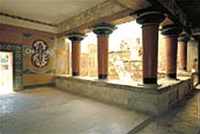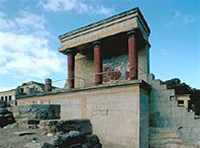 The name Knossos is mentioned in the Minoan tablets in Linear B. It is by this name that it is mentioned by Homer, who speaks of Knossos as a big city. The first palace of Knossos was built around 1900 BC, on the remains of a pre-existing Neolithic settlement, which had been inhabited since 6000 BC. This palace was destroyed around 1700 BC and, in its place, another one was built. During the period between1700-1450 BC, Minoan Crete, and especially Knossos, was at the height of its brilliance and power. In 1600, a destructive earthquake caused serious damage. Soon, however, the necessary repairs were made and, at the same time, other sumptuous buildings were erected on the same site. Around 1450, a new catastrophe occurred - probably due to the eruption of the volcano on Thera - with destructive effects. Then came the invasion of the Achaeans and, a little later, during a battle, the palace was totally destroyed. After this, the palace area was no longer used, but Knossos continued to be an important city-state until the irst Byzantine period. During the Roman period, Gortyn was established as the most important town of the island and was the seat of the Praetorians, Knossos taking second place.
The name Knossos is mentioned in the Minoan tablets in Linear B. It is by this name that it is mentioned by Homer, who speaks of Knossos as a big city. The first palace of Knossos was built around 1900 BC, on the remains of a pre-existing Neolithic settlement, which had been inhabited since 6000 BC. This palace was destroyed around 1700 BC and, in its place, another one was built. During the period between1700-1450 BC, Minoan Crete, and especially Knossos, was at the height of its brilliance and power. In 1600, a destructive earthquake caused serious damage. Soon, however, the necessary repairs were made and, at the same time, other sumptuous buildings were erected on the same site. Around 1450, a new catastrophe occurred - probably due to the eruption of the volcano on Thera - with destructive effects. Then came the invasion of the Achaeans and, a little later, during a battle, the palace was totally destroyed. After this, the palace area was no longer used, but Knossos continued to be an important city-state until the irst Byzantine period. During the Roman period, Gortyn was established as the most important town of the island and was the seat of the Praetorians, Knossos taking second place.During the Venetian period, Knossos sank into oblivion, its glorious name was forgotten, and it was only mentioned thereafter, and until not so long ago, as "Makrytoichos" (Long Walls). It was now only a small settlement built on the Roman ruins, which got its name from a long wall, surviving from Roman Knossos.
Almost all the ruins of the palace which have survived today, belong to the Neo-palatial period.
 In 1878, Minos Kalokairinos, a citizen of Herakleion fired with a great love for antiquity began, on his own private initiative, the first trial excavations on the Knossos hill - a site which, at thattime, was covered by arable land.
In 1878, Minos Kalokairinos, a citizen of Herakleion fired with a great love for antiquity began, on his own private initiative, the first trial excavations on the Knossos hill - a site which, at thattime, was covered by arable land. He uncovered a number of large jars and other objects, but soon gave up his excavations. Systematic excavations of the site were begun in 1900 by the British archaeologist, Sir Arthur Evans, and his collaborators. The excavations were carried on intermittently for 35 years. Evans has left us an important collection of writings on his excavations of Knossos. They consist of four volumes (The Palace of Minos, ed.1921-1935), and a great many reports. The reconstruction of the palace of Knossos, executed by Evans, was considered by many too ostentatious and overdone, and he was criticized for using too much reinforced concrete. Despite this, however, it was later seen that the multistorey buildings would not have been able to stand up to time if they had not been sustained in this way.

